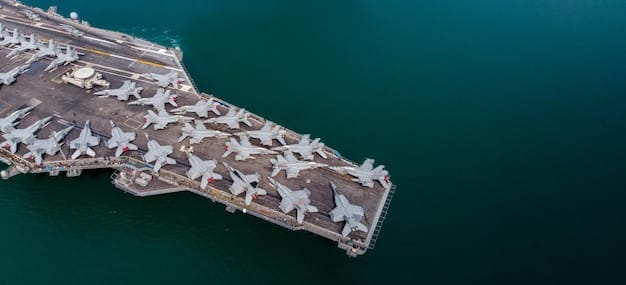Countering China: New US Military Strategies in the South China Sea

The US military is implementing new strategies in the South China Sea, focusing on enhanced naval presence, strengthened regional alliances, and advanced technological deployments to counter China’s growing influence and maintain regional stability.
The escalating tensions in the South China Sea have prompted the United States to refine its military strategies. Understanding what are the new US military strategies for countering China’s growing influence in the South China Sea is crucial for assessing the region’s geopolitical landscape and the potential for conflict.
Understanding China’s Assertiveness in the South China Sea
China’s growing influence in the South China Sea is a complex issue rooted in historical claims, economic interests, and strategic ambitions. This section explores the key factors driving China’s assertiveness in the region.
Historical Claims and Territorial Disputes
China asserts its claims over a vast portion of the South China Sea based on historical records and the controversial “nine-dash line.” This claim overlaps with the exclusive economic zones (EEZs) of several Southeast Asian nations, leading to territorial disputes and heightened tensions.
Economic Interests and Resource Control
The South China Sea is rich in natural resources, including oil and natural gas, which are vital for China’s growing economy. Controlling these resources is a key economic driver behind China’s actions in the region.
Here are some key factors that influence China’s actions:
- Strategic Location: The South China Sea is a crucial shipping lane for global trade, and controlling it enhances China’s strategic position.
- Military Expansion: China has been expanding its military presence in the South China Sea by building artificial islands and military installations, enhancing its power projection capabilities.
- Nationalism: The Chinese government uses the South China Sea issue to bolster nationalistic sentiment and maintain domestic support.
Understanding these motivations is essential for grasping the context of the US military strategies aimed at countering China’s influence. The US response is multifaceted, involving diplomatic, economic, and military elements.
Enhanced Naval Presence and Freedom of Navigation Operations
One of the primary US military strategies to counter China’s influence in the South China Sea is maintaining a strong naval presence. This involves conducting regular patrols and freedom of navigation operations (FONOPs) to challenge China’s excessive maritime claims.
The US Navy routinely conducts FONOPs to demonstrate its commitment to upholding international law and ensuring the free passage of ships through the South China Sea. These operations are designed to challenge China’s claims and prevent it from establishing de facto control over the waterway.
The US Navy is also increasing its presence in the region through:
- Increased Patrols: Regular naval patrols help maintain situational awareness and deter aggressive actions by China.
- Joint Exercises: Conducting joint military exercises with regional allies strengthens interoperability and sends a strong message of unity against China’s expansionism.
- Forward Deployment: Deploying more ships and aircraft to bases in the region allows for a quicker response to any potential crisis.
These naval activities are not just about military presence; they also serve as a symbol of US commitment to its allies in the region and to the principles of international law.
Strengthening Alliances and Partnerships in the Indo-Pacific
Recognizing the importance of collective security, the US is actively strengthening its alliances and partnerships in the Indo-Pacific region. This involves enhancing military cooperation with countries like Japan, Australia, and India, as well as forging new partnerships with Southeast Asian nations.
The US is working closely with its allies to develop a network of security partnerships that can effectively deter Chinese aggression and maintain regional stability. Here are some key aspects of this strategy:
The Quad Security Dialogue
The Quadrilateral Security Dialogue (Quad), comprising the US, Japan, Australia, and India, is a strategic forum that promotes cooperation on maritime security, counterterrorism, and other shared interests.
Bilateral Security Agreements
The US has bilateral security agreements with several countries in the region, providing a framework for military cooperation and mutual defense. These agreements are being strengthened to address the evolving security challenges posed by China.
- Joint Military Exercises: Regular joint military exercises with allies enhance interoperability and readiness.
- Intelligence Sharing: Sharing intelligence on Chinese activities helps improve situational awareness and enables a coordinated response.
- Capacity Building: Providing military training and equipment to allies enhances their ability to defend themselves and contribute to regional security.
By strengthening these alliances and partnerships, the US aims to create a united front against China’s assertive behavior in the South China Sea.

Technological Advancements and Military Modernization
The US military is investing heavily in technological advancements and military modernization to maintain its competitive edge in the South China Sea. This includes developing and deploying advanced weapons systems, improving intelligence capabilities, and enhancing cyber warfare capabilities.
Advanced Weapons Systems
The US is developing and deploying advanced weapons systems, such as stealth aircraft, hypersonic missiles, and unmanned aerial vehicles (UAVs), to deter Chinese aggression and maintain its military superiority.
Intelligence, Surveillance, and Reconnaissance (ISR)
Improving intelligence capabilities is crucial for monitoring Chinese activities in the South China Sea. The US is investing in advanced ISR technologies, such as satellite surveillance and electronic warfare systems, to gather real-time information on Chinese military deployments.
Here are examples of modernization and technological advancements being implemented:
- Cyber Warfare Capabilities: Enhancing cyber warfare capabilities allows the US to disrupt Chinese military operations and protect its own networks from cyberattacks.
- Artificial Intelligence (AI): Utilizing AI for data analysis and decision-making can improve the efficiency and effectiveness of military operations.
- Space-Based Assets: Relying on space-based assets for communication, navigation, and surveillance provides a strategic advantage in the South China Sea.
These technological advancements are designed to ensure that the US military remains ahead of China in terms of military capabilities and can effectively counter its growing influence in the region.
Diplomatic Engagement and International Law
While military strategies are important, the US also recognizes the importance of diplomatic engagement and adherence to international law in addressing the South China Sea issue. This involves working with regional partners to promote peaceful resolution of disputes and upholding the principles of freedom of navigation and respect for sovereignty.
Supporting the Rule of Law
The US is a strong advocate for the rule of law and encourages China to respect international legal norms, including the United Nations Convention on the Law of the Sea (UNCLOS). The US supports the 2016 ruling by the Permanent Court of Arbitration, which invalidated China’s “nine-dash line” claim.
Multilateral Forums
The US actively participates in multilateral forums, such as the East Asia Summit (EAS) and the ASEAN Regional Forum (ARF), to address the South China Sea issue and promote dialogue among regional stakeholders.
Furthermore, the US employs different diplomatic channels, such as:
- Bilateral Dialogues: Engaging in bilateral dialogues with China to address concerns and seek common ground.
- Regional Cooperation: Working with ASEAN member states to develop a code of conduct for the South China Sea.
- International Pressure: Building international consensus against China’s assertive behavior and encouraging it to abide by international law.
By combining diplomatic engagement with military deterrence, the US seeks to manage the South China Sea issue in a way that promotes stability and prevents conflict.
Economic Strategies and Trade Relations
Economic strategies also play a crucial role in countering China’s influence in the South China Sea. The US is working to promote economic cooperation with regional partners, reduce reliance on Chinese trade, and promote sustainable development in the region.
Promoting Economic Cooperation
The US is actively promoting economic cooperation with countries in the Indo-Pacific region through initiatives such as the Indo-Pacific Economic Framework (IPEF). This framework aims to strengthen trade ties, promote digital economy, and foster sustainable development.
Reducing Reliance on Chinese Trade
The US encourages countries to diversify their trade relationships and reduce their reliance on Chinese trade. This involves promoting alternative supply chains and supporting the growth of domestic industries in the region.
The US is also looking to:
- Investment in Infrastructure: Investing in infrastructure projects in the region to counter China’s Belt and Road Initiative (BRI).
- Trade Agreements: Negotiating trade agreements with regional partners to create a more level playing field and promote fair trade practices.
- Economic Sanctions: Imposing economic sanctions on Chinese entities involved in illegal activities in the South China Sea.
By leveraging its economic influence, the US aims to create a more balanced and sustainable economic environment in the Indo-Pacific region, reducing China’s ability to exert economic pressure on smaller countries.
| Key Aspect | Brief Description |
|---|---|
| ⚓ Naval Presence | Regular patrols and FONOPs challenge China’s maritime claims. |
| 🤝 Alliances | Strengthening partnerships with regional countries like Japan and Australia. |
| 🚀 Technology | Investing in advanced weapons and ISR technologies. |
| ⚖️ Diplomacy | Promoting peaceful resolutions and upholding international law. |
Frequently Asked Questions
▼
The main goal is to counter China’s growing influence, ensure freedom of navigation, and maintain regional stability by deterring aggressive actions and upholding international law.
▼
The US Navy conducts regular Freedom of Navigation Operations (FONOPs) to challenge China’s excessive maritime claims and assert the right of free passage for all ships.
▼
Alliances are crucial. The US strengthens partnerships with countries like Japan, Australia, and India to create a united front against China’s assertive behavior.
▼
The US military invests in advanced weapons systems, ISR technologies, and cyber warfare capabilities to maintain a competitive edge and monitor Chinese activities.
▼
The US promotes economic cooperation, reduces reliance on Chinese trade, and supports sustainable development through initiatives like the Indo-Pacific Economic Framework (IPEF).
Conclusion
In conclusion, the new US military strategies for countering China’s growing influence in the South China Sea involve a multifaceted approach that combines enhanced naval presence, strengthened regional alliances, technological advancements, diplomatic engagement, and economic strategies. By implementing these strategies, the US aims to maintain regional stability, uphold international law, and protect its interests in the Indo-Pacific region.





